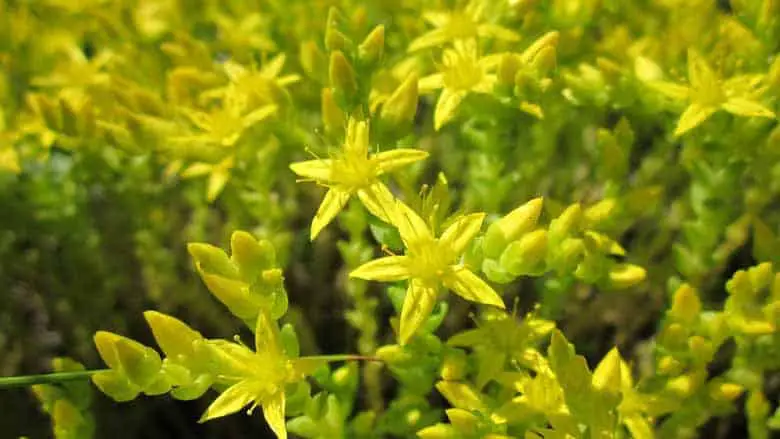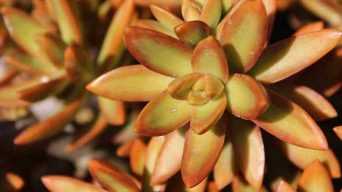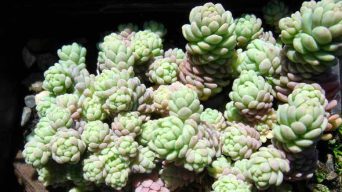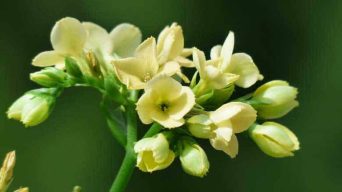If you are a succulent plant lover, then the Sedum acre ‘Goldmoss’ is the perfect addition to your collection.
The Goldmoss Sedum plant, or Goldmoss stonecrop as it is also known, is a low-maintenance succulent.
If you are looking for an easy-to-care-for plant that will add some color and texture to your garden, this Goldmoss Sedum care and propagation guide should provide everything you need!
Overview
The Sedum acre is a flowering plant in the Crassulaceae family that originated in Europe.
This Sedum variety is typically referred to by several common names, including:
- Goldmoss Stonecrop
- Goldmoss Sedum
- Mossy Stonecrop
- Biting Stonecrop
- Sedum Gold Moss
- Sedum Golden Moss
The Sedum acre is a mat-forming plant that typically grows up to 5 inches (12.5 cm) tall.
Goldmoss Sedum succulent plants have fleshy green leaves and sometimes display a red hue on their tips.
A small, yellow-star shaped flower with protruding stamens blossoms at the end of spring and lasts most of the summer.
How To Care for Sedum Acre ‘Goldmoss Stonecrop’
Goldmoss Sedum care is similar to many succulent plants.
This Sedum species is an easy-care houseplant because it is not too demanding and does well in low light conditions.
Sun Exposure & Light Requirements
Sedum Acre ‘Goldmoss Stonecrop’ grows best in full sun or partial shade. It will thrive in full sun, but it may require some protection from the hot afternoon sun.
This Sedum plant needs direct sunlight for a few hours in the morning and afternoon but protection from hot midday sunshine.
The Golden Sedum can also do okay with partial shade, but it will still need some morning and afternoon sun to thrive.
When grown indoors, the Goldmoss Sedum will need to be placed near a window or skylight and provided with at least four hours of direct light each day.
Watering Requirements
Goldmoss Sedum is a drought tolerant succulent that does not need a lot of water. They only need to be watered when the soil is dry.
Allow them to fully drain before watering again, as they do not like sitting wet for long periods.
Follow a regular cycle of watering your Goldmoss Sedum in the morning, then give it some time to dry out throughout the day and evening before giving them another drink.
Be careful not to overwater this plant because they do not need much water!
Soil Requirements
Sedum acre ‘Goldmoss’ thrives best in well-drained, gritty soil.
A mix of sand and peat moss works the best for Golden Moss Sedum care because they retain moisture while still draining quickly enough.
A cactus/succulent mix will also work well for Goldmoss Sedum care.
A succulent mix is also an excellent choice for Gold Moss Sedum propagation. This type of soil tends to be very light and porous, which will not retain too much water or fertilizer.
Temperature and Humidity
Just like any other succulent, goldmoss Sedum requires a temperature range of 60-75 degrees F (16-24 degrees C) and humidity levels around 50%.
This Goldmoss Sedum does not like being too hot or cold, so you’ll want to ensure it stays somewhere in the middle.
The air should also have good circulation around plants for adequate cooling and heating.
Fertilizing
Sedum acre ‘Goldmoss’ doesn’t need to be fertilized, but use a slow-release fertilizer if you do. Slow-release fertilizers are usually made for plants that require less fertilizer.
A slow-release fertilizer is a good option because it will provide the plant with nutrients over time instead of all at once like other types of fertilizers would do.
If you want your Goldmoss Sedum to grow tallest and fastest, then using some liquid or granulated fertilizer will be most effective on this particular species.
Liquid or granular fertilizers should only be applied when watering every two weeks during its active growing season (spring).
Potting and Repotting
Repotting the Goldmoss Stonecrop is best done in the early spring or summer.
To repot, remove it from its container and inspect the roots for damage (such as dryness).
If the root ball appears to be healthy, proceed with the potting process.
Fill a new pot that’s at least two inches wider than an old container with fresh soil mix: one part peaty sand, one part perlite, and three parts quality all-purpose cactus/succulent potting mix.
Gently loosen the roots from the sides of the old container and then plant the Sedum ‘Goldmoss’ in the new pot.
Pruning
There is little need to prune Sedum acre ‘Goldmoss’ plants. They will grow naturally into a cluster of gold-colored leaves.
Pruning is only necessary to remove old, brown foliage or those close to the ground and shade other areas near them.
Remove dry brown foliage by using a sharp pair of garden shears.
Cut away old stems at the base where they connect with the roots if needed. These may be decaying and can spread disease to other parts of your Golden Sedum plant’s root system.
Pests and Diseases
Pests and diseases are not significant concerns with Goldmoss Sedum but watch for aphids or mealybugs.
These pests can cause the Golden Sedum to weaken if left unattended.
To get rid of these insects, wash the plant with a strong sprayer of water.
Then, use insecticidal soap to kill any aphids or mealybugs that have survived on the leaves.
If these pests are still persistent, consider using a neem oil spray to keep them away from your plant.
This organic and environmentally friendly option will not harm Sedum succulents or any other plants in your garden.
Spray every three days for about four weeks to get rid of all aphids on the leaves without damaging the plant’s growth cycle.
In terms of diseases, Goldmoss Sedum is more susceptible to leaf spot.
This can be combated with a fungicide, but it will not affect the plant’s growth cycle and should not spread. Keep an eye on the Goldmoss Stonecrop for any spots of browning or spotting that may indicate leaves are infected.
If you see these signs, apply the fungicide as soon as possible to get rid of leaf spot.
How to Care for the Goldmoss Sedum in Winter
Winter is coming. For Goldmoss Sedum plants, this means the time when they will need different care than in warmer seasons.
In colder months, Sedums should be brought indoors to a location with plenty of light and warmth (at least 60° F).
The Sedum Acre plant does not require much water during these cold days, so watering only once every few weeks will suffice.
Never allow the potting mix around the gold moss succulent to dry out completely, or it can die off quickly!
In addition, Goldmoss Sedum plants require a period of dormancy in winter.
It is important to cut back on watering and give the plant some time to rest before it can be rejuvenated again by springtime.
Be sure not to disturb the Sedums during this hibernation phase!
They need plenty of light but no water or fertilizer until late February, when they will resume their usual care.
Provide as much natural sunlight as possible during these months so that your gold moss succulent has enough energy for new growth once warm weather returns.
How To Propagate Sedum Acre ‘Goldmoss Stonecrop’
Sedum acre ‘Goldmoss Stonecrop’ propagates from a stem cutting.
To propagate the Sedum ‘Gold Moss’, take a stem cutting from an existing Goldmoss Stonecrop plant.
To do this, simply cut a stem from the plant and then allow the cut end to callous for about one week before planting.
Place the cut end in a well-draining succulent potting mix, then water it thoroughly.
After a few weeks, the plant should start to show signs of growth.
Is the Sedum Acre ‘Goldmoss’ Toxic?
The Sedum Acre ‘Goldmoss’ is not toxic to humans, but it does have a mild toxicity towards cats and dogs.
Make sure that the Sedum Gold Moss plant isn’t within reach of pets so they don’t accidentally ingest any part of it.
Final Thoughts
The Goldmoss Sedum plant is an excellent addition to any succulent hobbyist’s collection.
Sedum Gold Moss care and propagation are really not too difficult.
The plants are a joy to grow, do well in many different environments indoors or out, and propagate easily with cuttings.
The Sedum Acre ‘Goldmoss Stonecrop’ is an excellent choice for first-time gardeners and experts alike.







